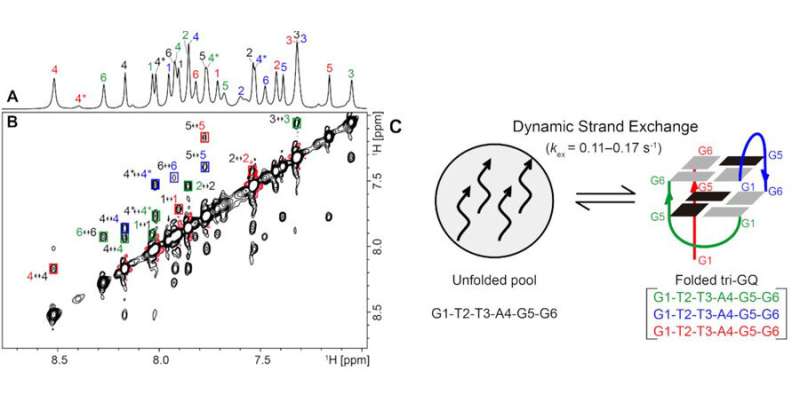Scientists discover dynamic trimolecular G-quadruplex

As an important non-canonical DNA secondary structure in vivo and in vitro, G-quadruplexes (GQs) have been widely investigated in many fields including biology, medicinal chemistry, supramolecular chemistry and nanotechnology. Vast GQs are primarily folded by one, two or four G-rich oligomers, rarely with an exception.
However, a research group from the High Magnetic Field Laboratory (HMFL) of the Chinese Academy of Sciences (CAS) reported their new discovery recently with the help of the solution Nuclear Magnetic Resonance (NMR) technology.
"Our work is the first to display a dynamic trimolecular G-quadruplex (tri-GQ)," said Zhang Na, who led the team. "It is solely assembled through the self-trimerization of d(GTTAGG), preferentially in Na+ solution tolerant to an equal amount of K+ cation."
This examined sequence d(GTTAGG) could be regarded as either a reading frame shifted single repeat of human telomeric DNA, which is tightly related to cancer and aging, or a 1.5 repeat of Bombyx mori telomeric DNA.
The team demonstrated how eight guanines from three asymmetrically folded strands of d(GTTAGG) organized into a two-tetrad core, which featured a broken G-column and two width-irregular grooves.
To their surprise, they found that the well-ordered tri-GQ of d(GTTAGG) is not a static structure. "It is a dynamic assembly having a life with constant movement." Zhang Na said excitedly, "this dynamic phenomenon is particularly suitable for an NMR study."

Two-dimensional rotating frame overhauser effects spectroscopy (ROESY) spectrum verified that fast strand exchanges on a timescale of second at 17℃ spontaneously occured between folded tri-GQ and unfolded single-strand of d(GTTAGG) that both species coexist in dynamic equilibrium.
The polymorphism has been thought as an inherent feature for GQs. This demonstration will make GQ structures even more diverse with potentially more functional applications.
More information: Haitao Jing et al. NMR structural study on the self-trimerization of d(GTTAGG) into a dynamic trimolecular G-quadruplex assembly preferentially in Na+ solution with a moderate K+ tolerance, Nucleic Acids Research (2021). DOI: 10.1093/nar/gkab028
Journal information: Nucleic Acids Research
Provided by Chinese Academy of Sciences




















